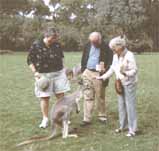Nosokinetics
Contents of June 2006 Issue
(comments to rjtechne@iol.ie)
'Grandad, What does nosokinetics mean?'
Dear ChloeYou asked me 'What does nosokinetics mean?' That’s a good question. It made me think. As Mummy said 'How do you explain to an eight year old what nosokinetics means?'

Fig 1: Chloe
If you look in a big dictionary you will find words like it, but you won’t find nosokinetics because I made it up. Even my spell checker keeps drawing a red line under it to show me it doesn’t exist. Yet, it does now. For Nana, bringing in my morning coffee, has just said: "It’s written on my conference bag." Still that doesn’t tell you what it means, so I better get on and answer the question.
"What does nosokinetics mean?" Noso is the Greek word for disease and kinetics is the Greek word for movement. Diseases make us sick and hospitals treat sick people. Hence, nosokinetics describes how health care systems handle patients.
If you look in a big dictionary you will find that pharmacokinetics (drug, movement) describes the way that our bodies handle drugs. A hundred years ago, long before I was born, doctors did not know how our bodies absorbed, distributed, digested and excreted drugs. Now, because a new science was created, we do know how and why drugs work.
When I was a young doctor I thought I knew everything that there was to know about how sick people move through hospitals. Then I found out that I was wrong. Now due to the efforts of a small group of people, in different parts of the world, a new science (nosokinetics) is being created which we believe will transform the way that activity in hospitals is measured, modelled and planned.
Now that you are eight years old, you are coming to stay. If you like I will tell you more about it when you come.
Love, Grandad
Forthcoming conferences
EURO XXI 21st European Conference on Operational Research, Reykjavik, Iceland July 2-5, 2006 OR in Health Care Sally Brailsford S.C.Brailsford@soton.ac.uk & Jan Vissers vissers@bmg.eur.nlOR 48 The Annual Conference of Operational Research Society, Bath, UK, 11-13 September 2006. Bath - a beautiful town with lots of interesting history and culture See http://www.orsoc.org.uk/ for more details.
RSS 2006 International conference of the Royal Statistical Society. Queen’s University Belfast, 10-14th September 2006. contact p.gentry@rss.org.ukn
Recent Conference in Adelaide
This explored some issues in the developing Nosokinetics scene. Ed.
Nosokinetics: Mission and Scope
We have a mission document agreed by the group at the conference.
Nosokinetics - Staking our claim
We also have conference papers by Mark Mackay, University of Adelaide, and by John O'Brien; what follows is some additional user feedback comment:
Nosokinetics: Which flows? What scope? and an analogy:
Geoff McDonnell, Director Adaptive Care Systems, Simulation Research Fellow Centre for Health Informatics, University of New South Wales, AustraliaI see several difficulties in scaling up your "nosokinetics" origins of geriatric inpatient flow meets mathematics (more specifically Peter meets Sally):
1. Which flows are of interest? Patients, Staff, Other resources, Information, Knowledge?
2. What is the scope of the system of interest?
A recent review of multiscale modelling from cell to organ inside the human body captures the issue rather well.
Bassingthwaighte, J. B., H. J. Chizeck and L. E. Atlas (2006). "Strategies and tactics in multiscale modeling of cell-to-organ systems." Proceedings of the IEEE 94(4): 819- 831.
"...Modeling is essential to integrating knowledge of human physiology. Comprehensive self-consistent descriptions expressed in quantitative mathematical form define working hypotheses in testable and reproducible form, and though such models are always 'wrong' in the sense of being incomplete or partly incorrect, they provide a means of understanding a system and improving that understanding…. Models (sic. of Physiological systems) are necessarily simplified to minimize computation and to emphasize the key factors defining system behavior; different model forms are thus often used to represent a system in different ways. Each simplification … reduces the range of accurate operability at the higher level model… The processes of error recognition, and of mapping between different levels of model complexity and shifting the levels of complexity of models in response to changing conditions, are essential for adaptive modeling and computer simulation of large-scale systems in reasonable time...".
We were there.
Just to prove we were there, we show Sally, Elia and Gill having a post-conference feedback in Adelaide wild life park. We were overwhelmed by the support and especially grateful for the post conference contributions from John O’Brien, Geoff O’Donnell, Chris Bain and Mark Mackay featured in this issue.

Fig 1: Feedback Group
The facilities provided by Adelaide University were first class and the catering by the Union was second to none, rum babas and chocolate éclairs at coffee and tea breaks - what more would one want. Strict diet was the order of the day when we returned home.
Looking back strains the neck and makes one fall over one’s feet as one goes forward. Nevertheless, it would be remiss of us to ignore the tremendous effort that Mark Mackay to ensure our success. We also thank those of who came and those who contributed for without your contributions and presence our first conference would not have been such a resounding success.
We thank the Department of Health and Adelaide University for their sponsorship and giving us the courage to proceed. A special issue of the Australian Health Review is to be published and we have a commitment from Omega to publish four papers. All papers will be peer reviewed. The deadline for submission is 31st June 2006.
Thanks to a kind invitation by Sally McClean the next International Conference will be in Ireland in 2008.
MASH News: we will print a third issue if it arrives in time, and perhaps add it if late.
Some navigational notes:
A highlighted number may bring up a footnote or a reference. A highlighted word hotlinks to another document (chapter, appendix, table of contents, whatever). In general, if you click on the 'Back' button it will bring to to the point of departure in the document from which you came.Copyright (c)Roy Johnston, Ray Millard, 2005, for e-version; content is author's copyright,